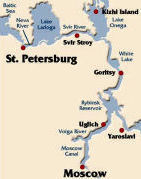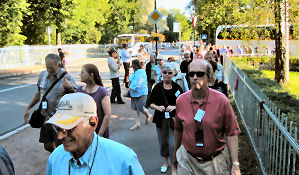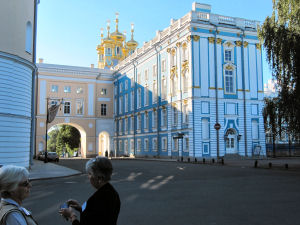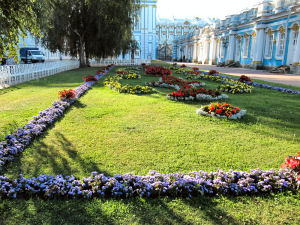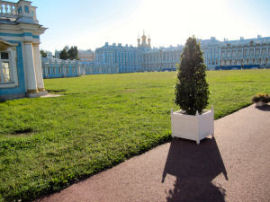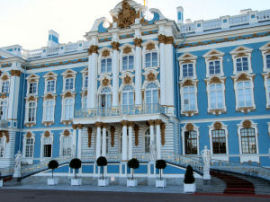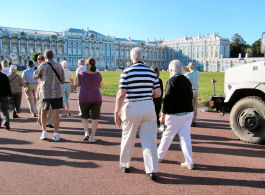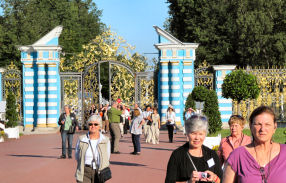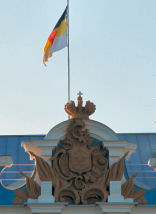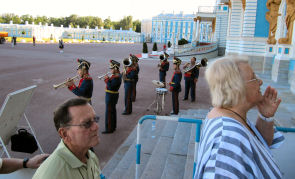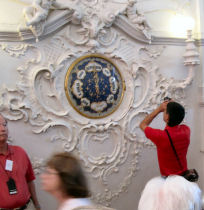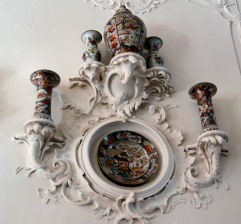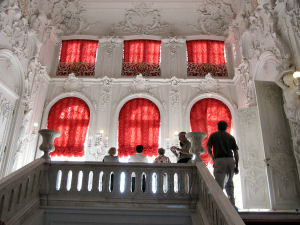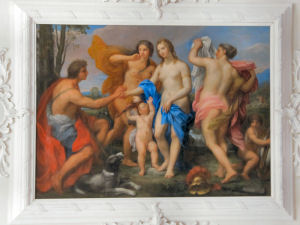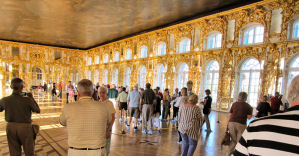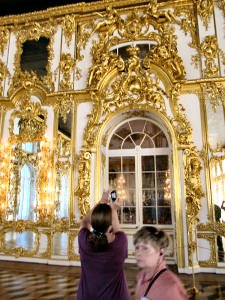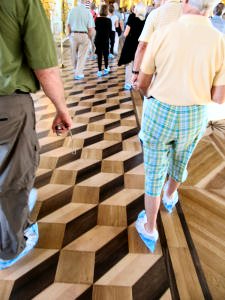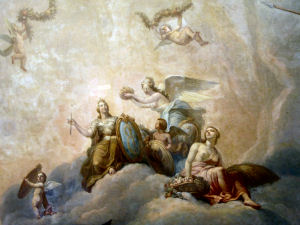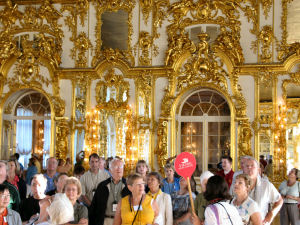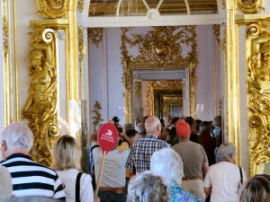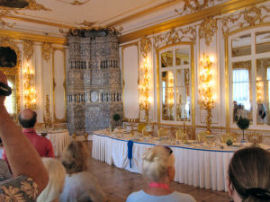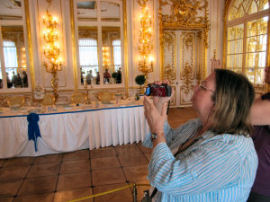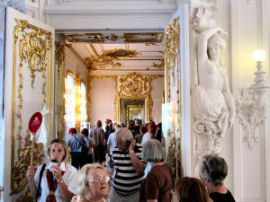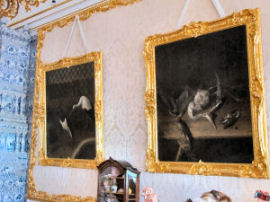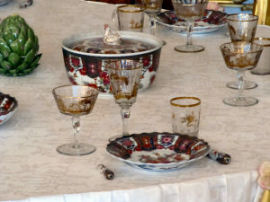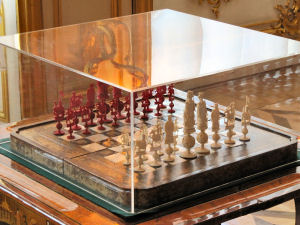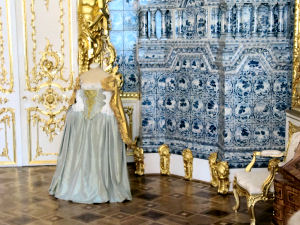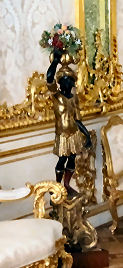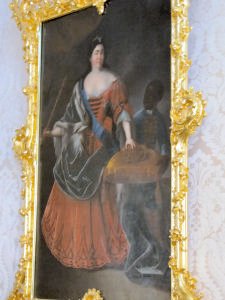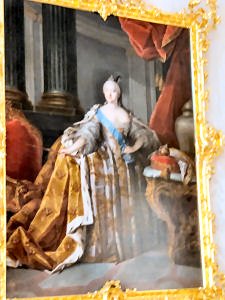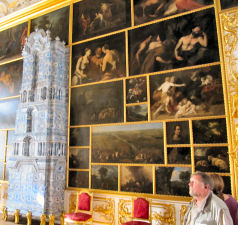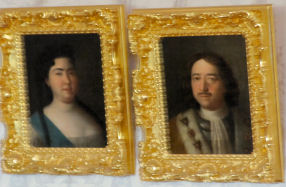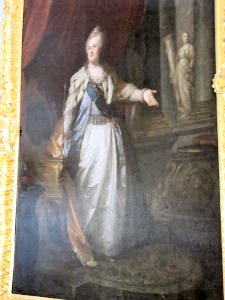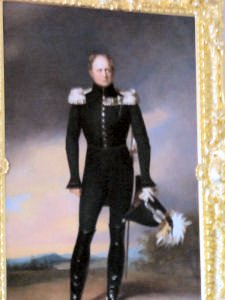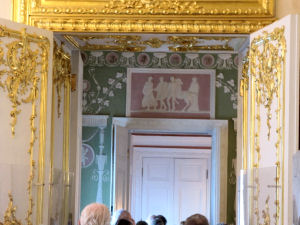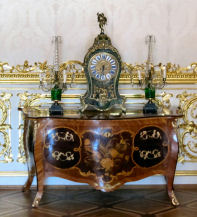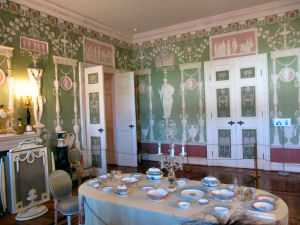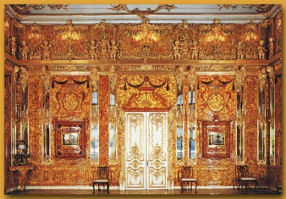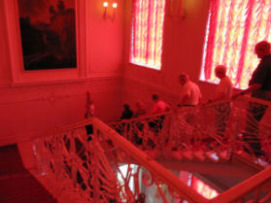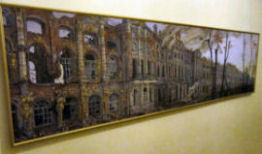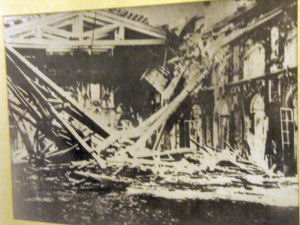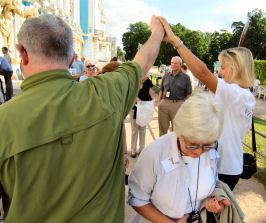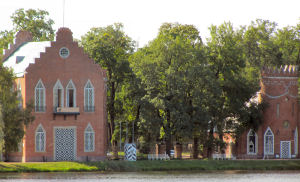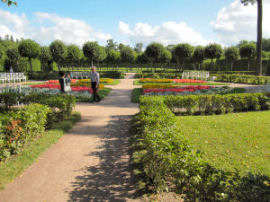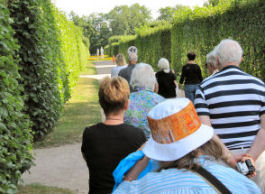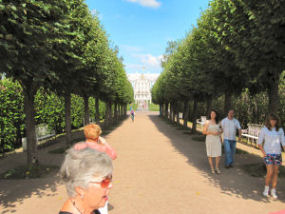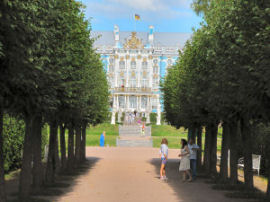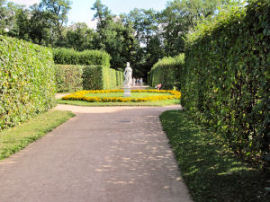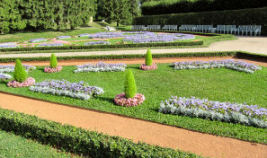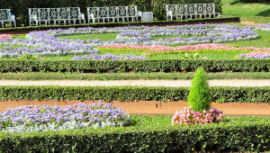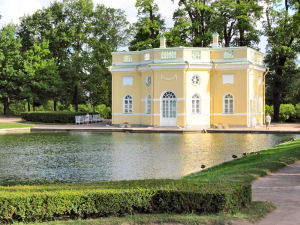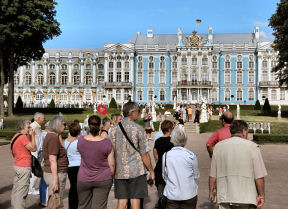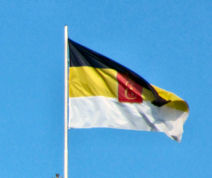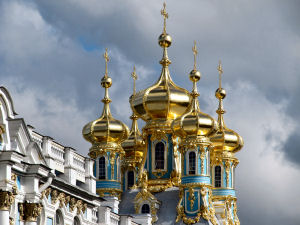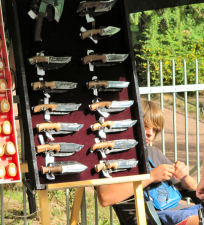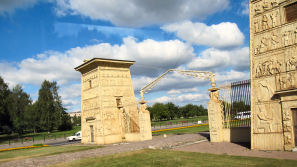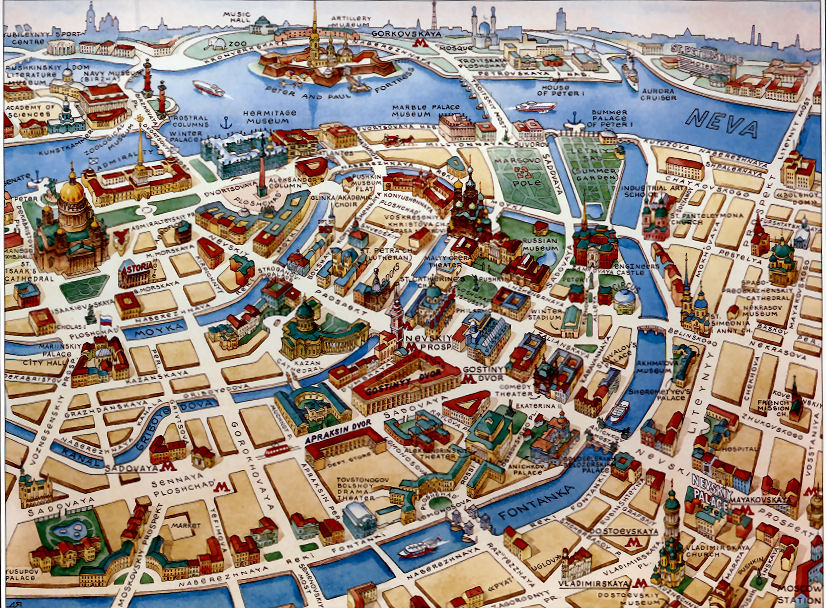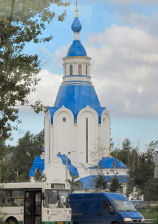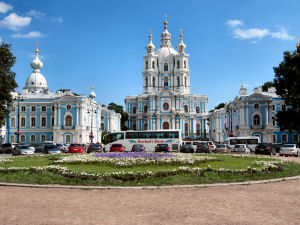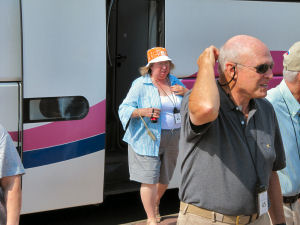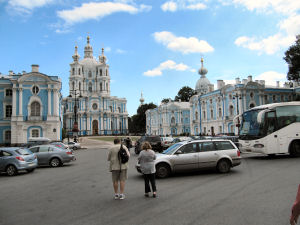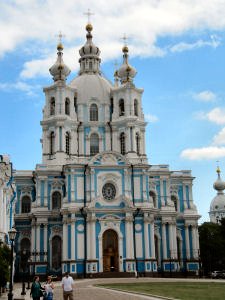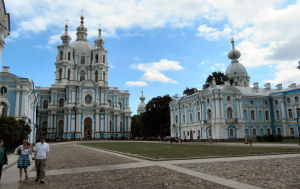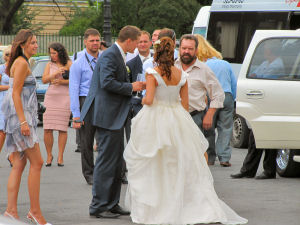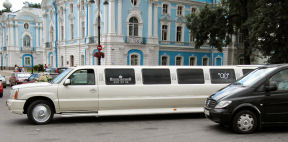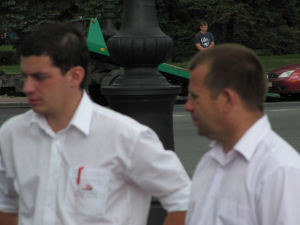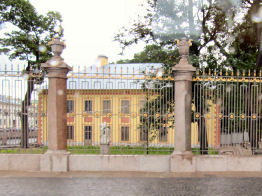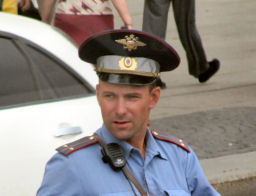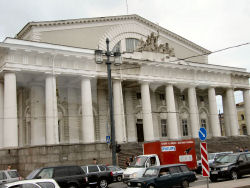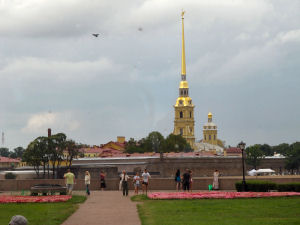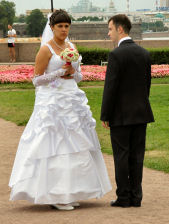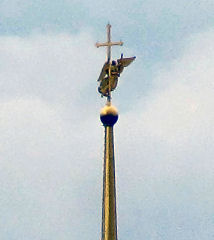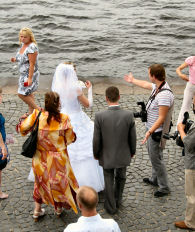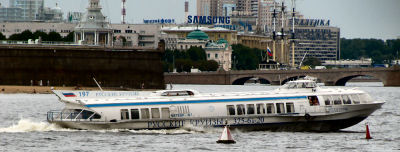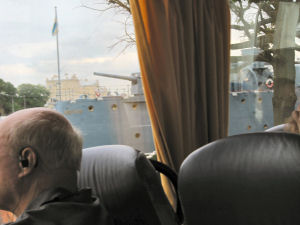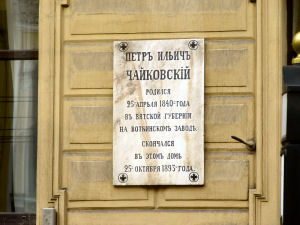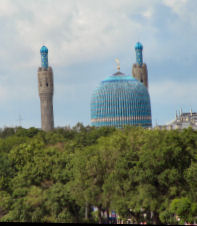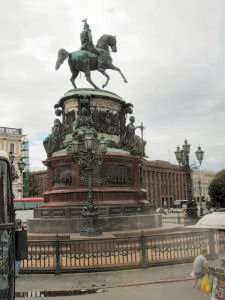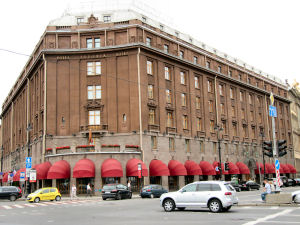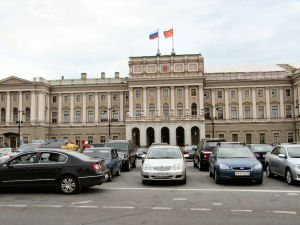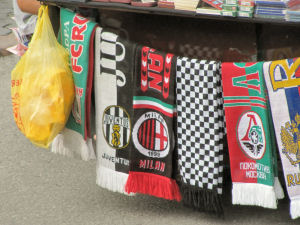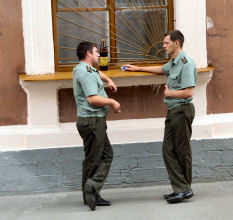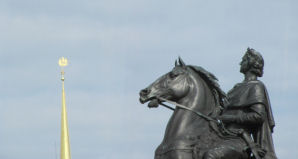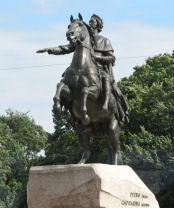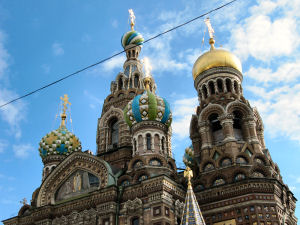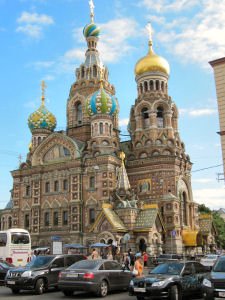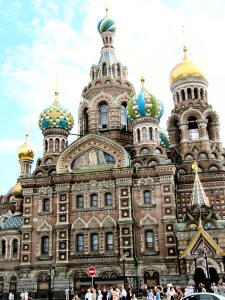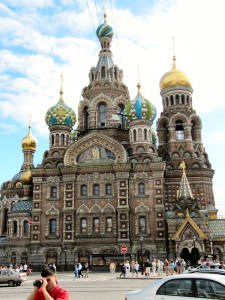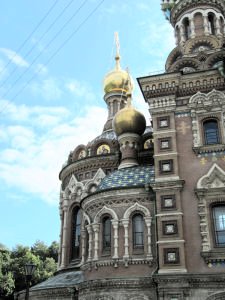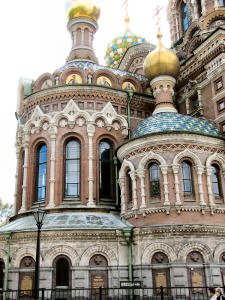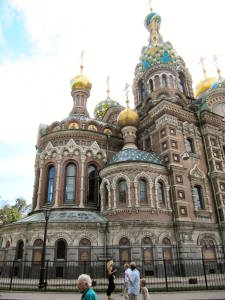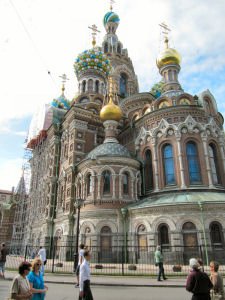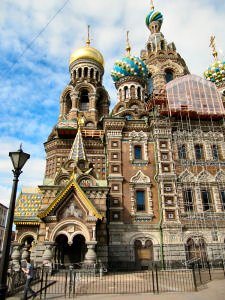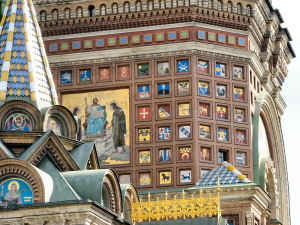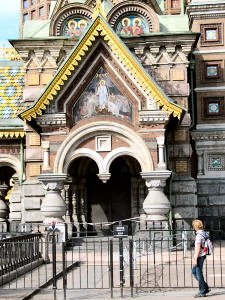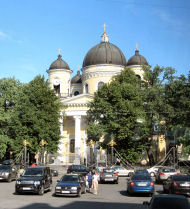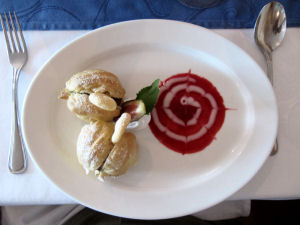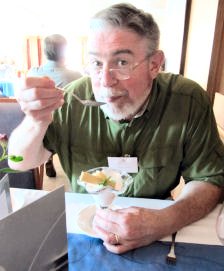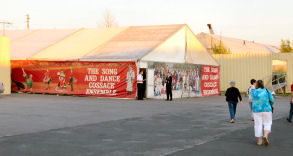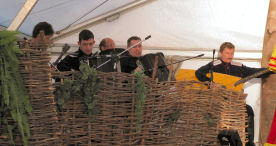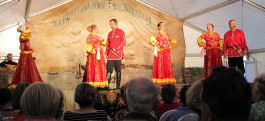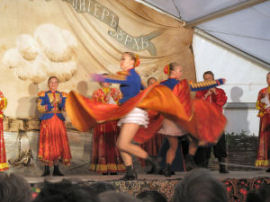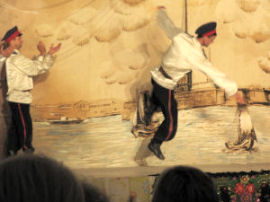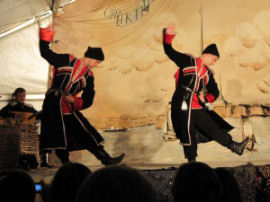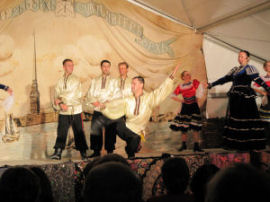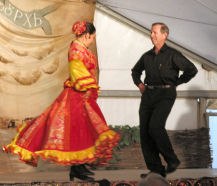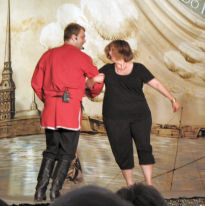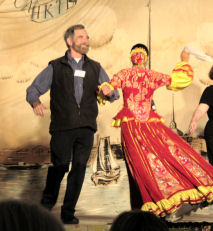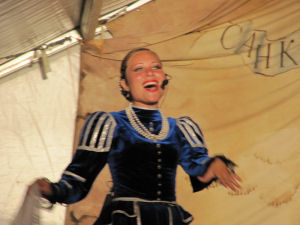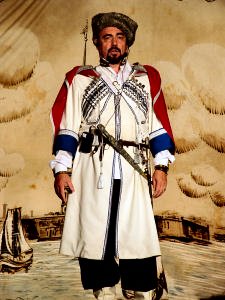Our destination for the morning was Pushkin town, formerly known as Царкое Село. Located due south of St. Petersburg, it was a favorite spot of the Russian royal family. Peter the Great built a huge (but not by his standards) palace[1] for his wife Katherine.[2] She was a Lithuanian[3] Lutheran named Marta Skavronska who adopted the name Katherine when she converted to the Russian Orthodox faith. She was the czar’s mistress for a few years before he devised a way of disposing of his inconvenient first wife. Peter and Katherine were married in 1707.
The temperature outside was in the sixties and seventies all day. It rained for a minute or two while we were on the bus heading south to Pushkin. Then it cleared up beautifully. The town was named after its most famous resident, Alexander Pushkin, who seemed to be universally considered by far the greatest Russian poet. He was Russia’s first great writer. In fact, according to Polina, his writing put all the previous works to shame. None seemed even to merit mentioning. All of the other highly respected Russian writers were his contemporaries. He published his novel in verse, Eugene Onegin, one chapter at a time – like Dickens – from 1825 through 1832 so that his legions of fans could get their Pushkin fix. The Golden Age of Russian literature began with Pushkin and continued throughout the nineteenth century. We passed a brace of German cannons that marked the closest point of advance of the Germans in the Siege of Leningrad. I wished that we had received a little notice of this. I did not have my camera ready as we sped by. As we entered town we passed Pushkin’s yellow house. Once again my camera was not at the ready, so I missed another photo.
When we got off of the bus, a small band was nearby. However, we arrived well before the palace officially opened because special arrangements had been made for us to get in early, and the musicians did not seem to be ready for us. We walked to the palace and discovered another band, and they were definitely fully prepared. We must have looked to them like rich Yankees. They started with “The Star-Spangled Banner.” I also recognized “Dark Eyes (Очи Чёрные)”, “John Brown’s Body,” a.k.a. “The Battle Him of the Republic,” and Gershwin’s “Summertime.” For some reason the sousaphone player was not wearing a hat.
The palace is famous for its Amber Room. Real amber is petrified tree sap, and it takes about fifty million years to make. Even though it is easy to fake with plastic, the real stuff is still extremely valuable.Francesco Rastrelli designed much of what is now known as the “Katherine Palace” for Empress Elizabeth. He also designed sixty-nine other palaces. Most of them were in Russia, and none were in his native Italy. The Throne Room that he designed for this palace was the largest baroque room in the world.
Nearly everything about the palace was destroyed in World War II. The ceiling of the Throne Room was restored from black and white photographs and from samples of other works by the same artist. Everything had to be reconstructed. It was considered 50 percent authentic and 50 percent reconstructed.
Although the palace was huge, not that much of it was open for tours. One could only get a vague tate of what it must have been like at one time.Mirrors were rare items until relatively recently. In the 1500’s a mirror was more expensive than a painting by Raphael.
In the first dining room that we entered Polina said something about a victory ribbon, but I did not get the details. The display featured authentic porcelain and crystal, which were taken away before the Nazis arrived. The cutlery that remained on display when we were there were only handles, because the metal parts were too heavy to carry.
In its heyday during Elizabeth’s time the palace was ready, willing, and able to receive noble guests twenty-four hours a day, 365 days a year. Even Katherine the Great entertained a few drop-in visitors. For some silly reason no photos were allowed in the Amber Room. They probably wanted people to purchase postcards or books that display it in all its glory. It did not work in my case; I easily located dozens of photos of the Amber Room on the web, and I had no scruples about expropriating one.
All the original amber was taken by the Germans and never recovered. Hitler reportedly valued it above gold. It was in the hands until of the Nazis until 1944. It was then sent to Königsberg, which hosted a famous amber works. In 1979 work began on reproducing the room. It was reopened in 2003.
After our tour of the palace, Polina led us to the picture gallery. The more interesting aspect of the history of the palace was not so much the outrageous opulence of the Romanovs as the destructive nature of the Nazis. One hundred photos documented the devastation of the war and the steadfast effort to restore the buildings as much as possible.
I wrote in my notebook that they never found Katherine’s last will. I think that this must have referred to the first Katherine, the wife of Peter the Great. Evidently a will favoring Peter I’s grandson, also named Peter, was forged and served as the basis for his ill-fated reign, which began in 1727 and ended in 1730.
Elizabeth II entertained as many as nine thousand people at a time! Polina reported that Elizabeth’s favorite food was olives stuffed with the tongues of nightingales. Katherine II, on the other hand, entertained less than a dozen. She preferred potatoes and pickled food. Although she was German by birth, she favored – at least officially – all things Russian to prove her legitimacy as a ruler.
For a very short period in 1762, Russia had three emperors. Ivan VI, the youngster whom Elizabeth had deposed, was still imprisoned. Katherine the Great overthrew her husband Peter III, and placed him in custody. Peter was assassinated shortly thereafter; Ivan lived two more years. Katherine took steam baths and then jumped in cold water or snow. This has remained, for reasons that baffle most of the rest of the world, still popular in Russia. They also love to beat their skin with birch branches. On the other hand, they do not torture themselves with rap music.
During the reconstruction approximately five hundred kilograms of gold were used to gild the interior and exterior of the palace. At $1200 per ounce, that amounts to about $4.4 million in raw materials alone.
We were allowed some free time before we were supposed to regroup at the mirror at the far end of the lengthy row of gift shops. I had no interest in shopping, so I found a seat near the mirror. I was soon joined by some Japanese ladies and people with mobility problems. Polina’s group assembled ten or fifteen minuts later.After we got outside, Polina and Tom formed an arch with their extended hands, and each of us had to pass beneath it so that Polina could count us. She told us that this was an old Russian custom, but that the people who participated usually made many arches. Each couple ran to the other end after going through the last arch. Polina said that part of the custom was that at the conclusion Tom was expected to propose to her. I thought for a moment that he just might take advantage of the opportunity.
After a pleasant stroll around the grounds we then had to pass through an even longer line of vendors with touristy knickknacks and other items. The most bizarre booth was near the end. A young man sold formidable-looking knives. Perhaps they were made from the Romanov’s cutlery.
Our bus’s departure was delayed for a few minutes because we were missing four people. It always seemed like a small victory to me when Sue and I were not the last people to arrive on the bus.
The town of Pushkin had recently become fairly wealthy. It had an attractive location as the only elevated area in the Leningrad region.
Alexander Pushkin was one-fourth black.[4] Pushkin was married to a dark-haired blue-eyed beauty named Natalia Goncharova (Natasha for short) for six years. The couple had four children. A French military officer in exile named Georges d'Anthès, who was married to Natasha’s sister, allegedly called Pushkin “president of the Horn-Bearers Society” or something like that. At any rate Pushkin attributed the insult to his brother-in-law and challenged him to a duel in 1837. This was the thirtieth duel – and duels were illegal – in which the poet had participated. According to Polina, D'Anthès claimed afterward that he had meant to shoot in the air, but his hand shook and he shot and killed Pushkin. Right.Pushkin was a rotten husband to his wife and a poor father to his four children. He gambled away his money. After Pushkin’s death Czar Nicholas I paid all his debts. Natalia remarried Major General Lanskoy and died at age 41.
As our bus traversed the highway northward toward St. Petersburg I noticed that the roads seemed full of nice new cars and dirty old trucks. I also noticed that the Russians seemed to prefer larger cars than the norm in western Europe.Aside from the churches and the palaces that had been spruced up for the tourists, most of the buildings in and around this city were blocky and dingy. Many structures were rundown. The countryside seemed nice but surprisingly empty for such a large city.
The choices for lunch in the ship’s restaurant included: mixed garden salad with Viking dressing and croutons; curry soup with coconut milk and peas; coq au vin with tagliatelle, baby onions, and bacon or potato-zucchini frittata with basil sauce and pumpkin puree; apricot roulade served with fruit sauce or ice cup “Black Forest.” I chose the salad, curry soup, and the coq au vin, which I really enjoyed. I skipped dessert.We remarked on the fact that we had never seen coq au vin on a single menu in our tour of France in 2009.
Sue and I dined with the Corcorans, and we were joined by a couple from Maryland named Mary Kay and Peter. Talk naturally centered on Maryland, which is where both members of the next generation of Corcorans resided. Mary Kay and Peter also disclosed that they planned to take a taxi into town in the evening to eat at Palkin, a restaurant that was highly praised by my guidebook. They later told me that they had had a fabulous time. Peter reported that the sturgeon was unbelievable.Somehow the conversation turned to water hyacinth, which then led it to regular hyacinth. I ventured the crucially important information that hyacinth always set Curley Howard off, and the only antidote was, of course, cheese. When Peter said that he was a fan of the Bowery Boys, I gave him my favorite Leo Gorcey line: “I am going up to my room to ponder this question. Wake me up for dinner.”
The afternoon was devoted to an “included” tour of the highlights of St. Petersburg. I had fairly high hopes for this tour, but I was disappointed. As always, Polina filled the time on the road with interesting information. She told us that millions of Russians had left their villages in the twenties and thirties because of Stalin’s policies of collectivization and industrialization. In St. Petersburg the palaces were converted into communal flats. Each family was allotted one room. In the fifties and sixties Khrushchev addressed the dire housing problem by constructing new apartment buildings. These were generally five-storey buildings made out of cheap pre-fabricated units. Between 1957 and 1962 twenty-five million apartments in them were given away. They were supposed to be temporary, but they had never been replaced by anything else. By 2010 they were mostly in very bad condition or worse. The Soviet version of urban planning was based on “micro districts.” A number of “houses” were provided with everything within walking distance needed to sustain life: school, groceries, laundry, etc. They were supposed to function like a village. The concept did not work too well because people were allowed to shop outside of the assigned districts, and many did. In those days the salary was one hundred fifty rubles per month. It was enough to survive on, and lots of people went to the Crimea for holidays. The “houses” in the micro districts all looked the same, and the streets had similar names. A popular comical movie was shown on New Years in which a man accidentally goes to the wrong house and finds a single woman. The 1990’s were chaotic and lawless in Russia. Russians seemed universally to be of the opinion that the times had much improved since Putin took power.Most of us were surprised to learn that 65 percent of the Russian people consider themselves to be of the Russian Orthodox faith. Evidently seventy years of religious repression did not have the desired effect.
The energy company Gazprom was planning to build a huge facility called the Ochta Center. The ground had been cleared, but construction had not yet started. Its plans called for an office tower that would be the first edifice taller than the spire on the Peter and Paul Fortress. Our first stop was at the Smolny Convent and Cathedral, which is on the west bank of the Neva after it turns south. It is quite close to the planned site for the Ochta Center, which is disturbing to many people in St. Petersburg.The convent dates back to the early days of the Romanovs. A school was established there by Katherine the Great for the education of girls from aristocratic families. They were taken from their parents, and contact with their families was severely limited. The girls learned dancing, manners, French, some crafts, and the ability to make conversation. The facility was disguised by netting during World War II and went almost untouched by the German bombers despite the fact that all the buildings in the vicinity were destroyed.
We stopped for a few minutes of photo-taking. The bus passed the statue of Felix Dzershinsky (Феликс Эдмундович Дзержинский), the founder of the K.G.B. I missed three or four opportunities to take a photo of it. Polina said that at one time may cities had erected statues of him, but only this one remained. The others had been pulled down since the fall of the Communists.Polina informed us that her real job was teaching English and German. No one asked at what level she taught, and this obvious question did not even occur to me until much later.
Construction in the St. Petersburg area has historically been quite difficult. There are no stones in the area, a statement that probably sounded preposterous to my fellow New Englanders. Wood was not suitable because of its tendency to rot in a few years. In the city’s early years a tax of five stones was levied on anyone entering the city on foot, ten for those who came by carriage, fifteen for entry from a boat. The solution was to use stucco over stones, but the stucco needed to be replaced every few years. For the most part the city was designed and built by Italians. Polina amazed us with the revelation that the Crosses (Кресты) Prison on the other side of the river was still in use and in fact housed ten thousand inmates! The state also ran it as a museum. People could tour the prison, including the part that is in use. Needless to say, it was not on our itinerary. We saw the statue of Lenin in front of the Finland Train Station. Lenin was no longer revered in Russia, but his memory was still respected by many of its citizens.The bus passed near the cruiser Aurora. Its cannon was famous because its firing was the signal to begin the revolution in October 1917. The Bolsheviks seized the government with surprisingly little resistance.
Pavel maneuvered the bus past the Summer Palace of Peter the Great, a rather modest two-story yellow building. We could barely make it out through the foliage.In the eighteenth and early nineteenth centuries serfs constituted 85 percent of the population. The guides were quick to point out to us that serfdom was abolished in Russia before slavery was outlawed in the United State.
The public squares of Leningrad were used as gardens for the purpose of growing food during the Nazi siege. The Winter Palace was designed to be the first building seen by visitors approaching St. Petersburg from the sea. The first emperor to live there was Katherine the Great.The major bridges in Leningrad were drawn for ships from 2-4 a.m. every morning. If you found yourself on an island at two in the morning, you would be stuck for a few hours.
We stopped for photos on the “Spit” of Basil Island (Василевский Остров), which was what the corner of the island with the best view of Hare Island (the home of the Peter and Paul Fortress) and the mainland was called, to take photos. We saw several brides there posing in their bright white gowns with their beaux.
The Stock Exchange, which was very near the Spit, looked like a Greek temple. It had been transformed into a naval museums St. Petersburg boasts approximately two-hundred fifty museums. Ivan Pavlov was not only educated in St. Petersburg. His laboratory served as a museum. Among other things, he came up with the idea that an eight-hour day was the most efficient. He was a devout Orthodox Christian.We drove past “The Flying Dutchman,” a phony tall ship, which, according to Polina, was actually a fitness center. It evidently also included an upscale restaurant, a beauty salon, and a DJ bar.
The angel on top of the spire in the Peter and Paul fortress looked tiny, but it actually had a ten-foot wingspan.
The mosque in St. Petersburg was the northernmost in the world. It was on Hare Island. We glimpsed its dome and the minarets above the treetops.The bus drove by the brick house in which Peter the Great’s original log cabin was housed. I was unable to snap a photo of it.
In the time of Peter I, there were one-hundred sixty-five canals and no roads or bridges in the city. In fact, Peter forbade roads. He wanted the city to be completely and uniquely accessible by boat. As soon as he died, people began filling in many of the canals and made roads of them. Now there are thirty-five bridges. Polina also provided the number of canals, but I missed it.We got a good view of the “Big House,” the home of the K.G.B., but for some reason I did not get a good photo. Evidently the organization terrified everyone. One-third of the structure was located beneath the ground.
We then drove by the Michael Castle. Czar Paul I (1796-1801), who was justifiably afraid of being assassinated, spent a lot of time there. He put in a water moat to protect himself from outsiders. His fear was reasonable, but focused in the wrong direction. After only forty days his own servants arranged the assassination. Polina told us how he hid behind the fire screen, but one of the assailants realized that he was still in the room when he felt a warm spot on the bed.Dostoyevsky attended the Army Engineering College in St. Petersburg. The city still boasted a few museums devoted to his life and works.
The circus has been in St. Petersburg for centuries. Katherine the Great had thirteen elephants, presumably to be used when she had exhausted all of her stallions. One elephant was kept alive throughout World War II, and it somehow survived the siege. This may be the most amazing fact that I have ever learned.[5] Think of it. People were dying of starvation, but they maintained an animal that must have consumed close to three hundred pounds of vegetation per day.There were no traffic jams in the Soviet times for the simple reason that there were not very many cars. At first, people had been excited about the idea of traffic jams, but for obvious reasons the novelty had worn off. We did not encounter any debilitating traffic problems in St. Petersburg.
We parked the bus in Исаакиевская Площадь, or at least we tried to. So many buses were there that Pavel had to improvise a parking place. We were given a few minutes to photograph the sites, but not enough to visit the cathedral or any of the other buildings.I recorded that Polina said that St. Isaac’s Cathedral was the third largest domed cathedral in the world after St. Peter’s Basilica and St. Paul’s in London. St. Peter’s, however, has never been a cathedral. St. Isaac’s was evidently still sort of a cathedral.[6] One of the side chapels was used for regular services. The doors each weighed ten tons, but they opened easily. The gilded dome was a solution of gold and mercury. In one respect this was a very successful process; it has never needed to be regilded. Unfortunately, all sixty people who helped gild it died of mercury poisoning. Whoops.
In the middle of the square was the equestrian monument to Czar Nicholas I. It was the largest statue in which only two of the horse’s legs touched the ground. Weights had been placed in the rear section of the statue to provide stability. In most equestrian statues in which the horse was rearing, the tail was on ground.
The St. Petersburg Legislative Assembly met in Mariinsky Palace. It was originally constructed for Nicholas I’s daughter, Maria, but she moved out perhaps because she did not like the view of the horse’s rear end. They then pivoted the statue one-hundred eighty degrees. The bishop and other clergy complained about the view. So, it was pivoted back to its original position. The large brown building next to St. Isaac’s was the Astoria Hotel. Hitler had scheduled a victory reception in that hotel and in Red Square for August 9, 1942. Russian troops came upon the invitations in Germany.I must say that I found this stop frustrating and exasperating, but not as much as the next one, which was a two-storey souvenir shop. They were all ready for us. A guy stationed outside rapidly removed cones from a parking spot that had been reserved for bus #45. I stayed on the bus, and I was pretty surprised that no one else felt as I did, namely that I would rather be virtually anywhere else in St. Petersburg than trapped in a souvenir store. I definitely should have brought my computer in the afternoon. I was bored stiff.
When everyone had returned to the bus after six or seven hours of retail therapy, Polina resumed the history lesson. She started with Peter the Great’s love of Holland. He spoke Dutch and actually dressed as a Dutchman. He was a very skillful craftsman. His many skills even included dentistry. He allegedly extracted teeth from his ministers. When his successors needed information from their ministers, it only felt like they were pulling teeth. Russia’s first revolution was in December 1825. Approximately three thousand troops refused to swear loyalty to the new czar, Nicholas I. They expected to be joined by other soldiers, but instead they were soon suppressed by imperial artillery fire.Czar Alexander II, who reigned from 1855 to 1881 was killed near the site of the Cathedral of the Resurrection of Christ, better known as Church of Our Savior-on-Spilt-Blood. Alexander had freed the serfs in 1861. He also gave independence to Finland and Poland. His armies defeated the Turks and drove them from Bulgaria. His engineers constructed a network of railways. He reformed the justice system and established elective assemblies. A group named Народная Воля (People’s Will) was determined to assassinate the czar. He had already survived five attempts on his life when a bomb was thrown under his bulletproof carriage on March 13 (current calendar), 1881, by a young man named Nikolai Rysakov, who belonged to the group.
I thought that Polina said that the bomb killed seventeen people, but I was unable to verify that. At any rate Alexander survived, only to be felled[7] by a second young man who threw a bomb at the czar’s feet after he had left the carriage. Maybe this was the one that killed so many people. Evidently a third bomber was ready if the others failed.
The People’s Will was certainly thwarted. Alexander II’s plan for a constitutional monarchy with a Duma was scuttled forthwith by his successor, Alexander III. Nicholas II finally introduced more reforms, but it was too late.
One-hundred forty cities and towns donated money to the Cathedral. Their coats of arms were clearly visible on the side facing the bus. Gold and mosaics adorned the inside, but we did not have time to enter. In the 1930’s the cathedral was closed. One of the theater companies used it to store scenery. Then it was used for potato storage for several years. No services were conducted there in the twenty-first century except on Easter. It primarily functioned as a Museum of Mosaics. One of the most bizarre moments of the entire trip occurred as I hurried over to the other side of the church for additional photos. A street performer was playing the theme from the Flintstones on the accordion. Could this also be an old Russian folk tune? “Ябба Дабба Ду!”
Sue desperately wanted a photo of the four Nutmegggers with something distinctly Russian in the background. She finally got someone to photograph the four of us with this totally unique church behind us. Nevertheless, she got upset at me because I did not come over and stand next to her. I guess that I am just oblivious to the importance of this kind of thing.
Polina told us that Czar Paul I loved to make the soldiers parade around in front of him on the Field of Mars. He once saw a ballerina viewing them, and she confided to the czar that she also liked to watch them march. He then made all of the dancers in the Kirov company attend the marching drills every day. No wonder he was assassinated. Paul was the one who was murdered after hiding behind a screen for the fireplace. Alexander I, Paul’s son, may have been involved in the plot.Alexander I was reported to have died in a provincial village over the thirteen years later. Some time later a Siberian monk who looked and wrote like Alexander appeared on the scene. According to Polina he was never seen at confession. Nicholas I sought him out and would not reveal what he learned from his interview with the monk. Evidently the monk, whose name was Feodor Kuzmich, subsequently was elevated to sainthood in the Russian Orthodox Church.
“Dachas” were plots of land given by the Soviet state to families to use for weekends and holidays. They were allowed to construct small one-storey houses on them. Usually they had no facilities. Most urban families had one. The newer ones were much nicer than ones built in the Soviet era.
Nearly everyone in the cities lived in flats. Most of the flats were owned; very few were rented. A studio apartment might rent for $500 per month in St. Petersburg. It would cost much more in Moscow.
Polina – and everyone else who addressed the subject – insisted that education and medicine were better under the Soviets. A new law had recently been proposed in which the three major subjects would be free to Russian citizens, but they would have to pay for the rest. Polina was against this idea because irresponsible parents would not pay for good education. The kindergartens in Russia were, for some reason, still very good. A few private schools had recently been developed.Sue asked Polina if we could drive by the Transfiguration Cathedral. At first she said that we would not be able to do it, but Pavel found a way.
A bizarre feature of the Neva river was that sometimes its current flows in both directions, one caused by the tides and the other by the earth’s gravity.The bus tour was a huge disappointment. I wished that they had just let us wander around St. Petersburg on our own. It was compounded by the fact that the “shuttle bus” excursion for Thursday afternoon, which did just that, had been cancelled. Tom and I were two of the very few passengers to sign up for it. I decided to go to Yusupov Palace instead, despite the fact that it was not even mentioned in my guidebook. Tom decided to join Sue and Patti on the canal tour.
Supper in the ship’s restaurant featured a stuffed olive biscuit on asparagus salad with tomato vinaigrette or Russian farmer salad with smoked ham; beetroot soup with sour cream or beef bouillon with liver dumplings; turkey roulade with bell pepper ragout and mashed potatoes with sherry sauce or baked tilapia filet with sauce tartare and sautéed vegetables with dill potatoes; stuffed creamy profiteroles with fruit sauce or ice cup “Advocate.” I had the farmer salad, borscht, tilapia, and the profiteroles. After dinner all four of us walked over to the big tent for the Cossack show. They warmed us up with a free shot of vodka. We all enjoyed an evening of listening to some indecipherable but lively music and watching some indecipherable but lively dancing. I could have sworn that at the beginning of the show there were seven singers, and at the end there were only six. However, I took over one hundred photos, and not a one showed seven singers.I tried several times to get a photo of the gigantic bass balalaika in the band, but they were all a waste of pixels.
At the end of the performance, to the surprise of no one, the Cossack ladies came out into the audience and tried to persuade the rich tourists to buy their crafts and their DVD’s. Sue purchased a doll and a wooden noise-maker called a treshchotka (трещотка) from them.
What a day! It had probably too much for our jet-lagged memories. Perhaps the 386 photos that I took will help.
[1] The Alexander Palace website claimed that she ordered it for herself. At any rate, Peter was czar at the time (1717).
[2] The name in Russian is Екатерина. I decided that it made more sense to translate this as “Katherine” rather than “Catherine.”
[3] Her Wikipedia entry insisted that she was born in Estonia and that her father was a Latvian peasant of Polish origin.
[4] Although I wrote down 1/4, I am pretty sure that Pushkin was actually only one-eighth black. His great grandfather (his mother’s father’s father), Abram Petrovich Gannibal, was from Africa. He was given to Peter I when he was eight and rose to become an important Russian noble. His wife was definitely not from Africa.
[5] Here is another contender: If you pick up a guinea pig by its tail, its eyes will fall out. Try it.
[6] In the Roman Catholic Church every bishop has a cathedral and vice-versa. The pope’s cathedral is St. John Lateran. There seemed to be dozens of cathedrals in St. Petersburg. Surely there was never an equivalent number of bishops.
[7] So both Abraham Lincoln and Czar Alexander freed the slaves and then ended up eliminated by assassins.
